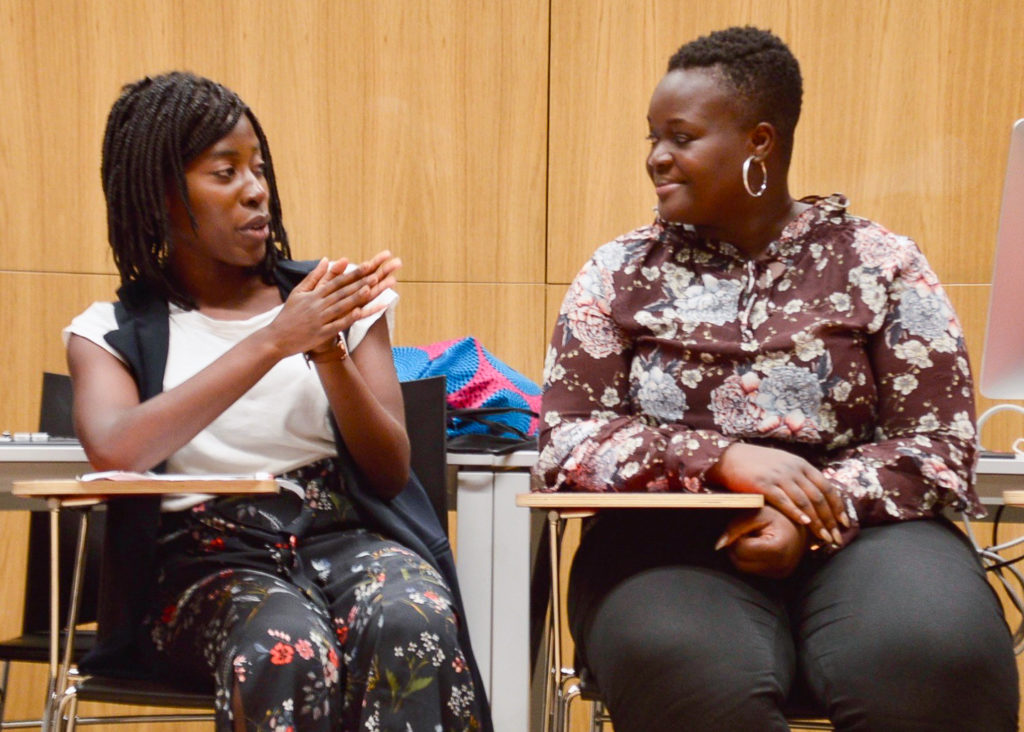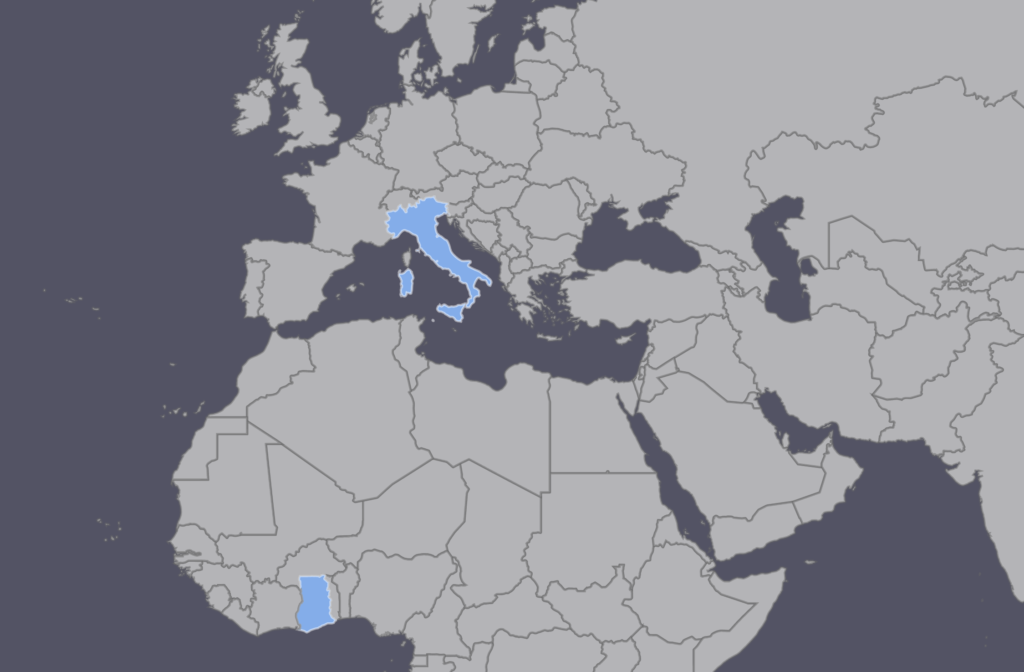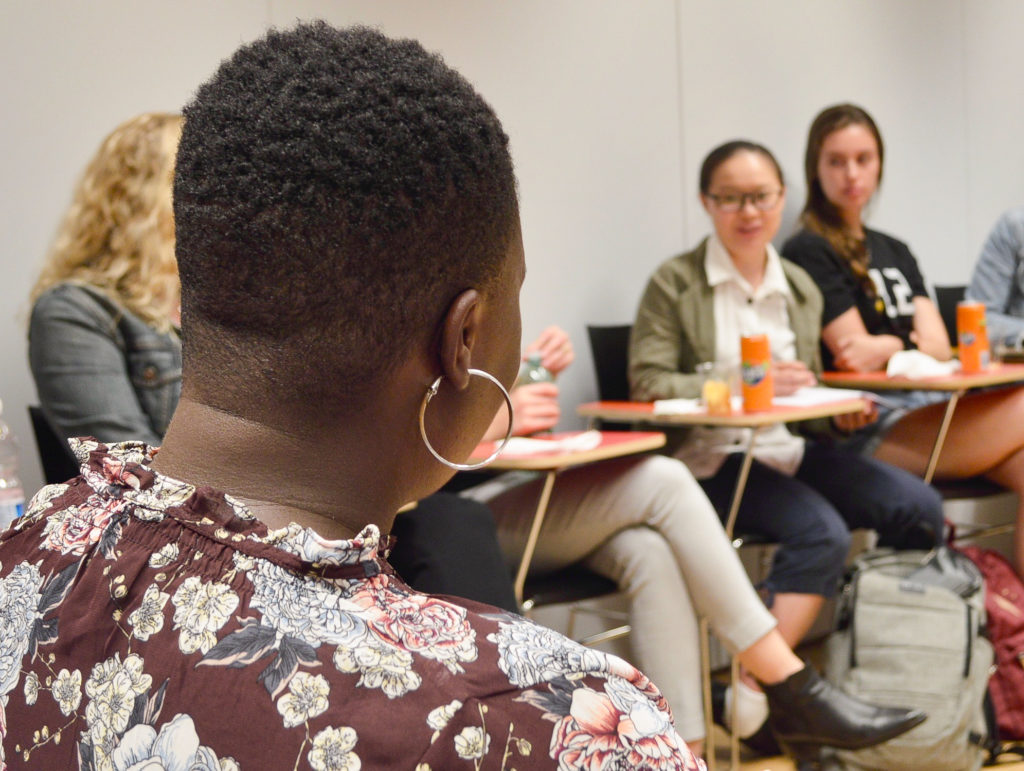I’ve enjoyed attending guest lectures since I was a first-year at Holy Cross. I love not only learning about our visitors and the work they do, but also listening to the community discussions and engaging in the Q&A sessions afterward. I was excited to hear that we were getting a visitor on campus for a discussion on an important topic: race in Italy.
I signed up to attend the event right away. I knew from the start that this discussion would enrich my experience and goals at Temple Rome. I am taking two classes relating to race in Italy this semester. These were the courses I wanted to take since the moment I saw them on Temple Rome’s website last semester. One is a political science course called “Immigration, Race, and Identity in Contemporary Italy.” The other is a Classics course called “Race in the Ancient Mediterranean.”
I was thrilled to secure seats in both of the classes and was excited to compare and contrast the role of race and identity in Italy from both ancient and modern perspectives. I knew my family’s story of moving to the United States from a different country. I know how my race and identity have shaped my experience as a minority from an immigrant family. And now I have the chance to learn someone else’s story through a discussion on race in Italy.
Our guest was Susanna Twumwah, a local activist who will be graduating soon with a degree in International Relations and Development. She is part of the association QuestaèRoma (Italian for “This is Rome”), which addresses racism and discrimination through activities involving art, sports, and cultural heritage. QuestaèRoma also advocates for a more inclusive definition of Italian citizenship. Susanna hosts workshops for communities who arrived as part of a diaspora into not only Rome and other places in Italy, but also in different places abroad as well.
Benedicta Djumpah, who works as a student life assistant at Temple University Rome, is an activist as well and hosted the discussion alongside Susanna. I see Benedicta a lot on campus and enjoy talking to her in my free time. We have conversations about growing up as minorities in our communities and how we empower ourselves to find our own paths and adapt to the world around us. I am grateful to Benedicta for her orientation speech on how the Italian concept and perspective on race are different from how American students see race and racial issues in the United States. The information in her presentation was useful and helped me adjust to living in Rome.
 Benedicta (left) hosted a discussion with Susanna Twumwah (right) on Race in Italy. Photo by Jesse Gardner, Temple University ’21, taken and used with permission from the Temple University Rome Facebook page.
Benedicta (left) hosted a discussion with Susanna Twumwah (right) on Race in Italy. Photo by Jesse Gardner, Temple University ’21, taken and used with permission from the Temple University Rome Facebook page.
Both Benedicta and Susanna are of Ghanaian descent and are part of the Afro-Italian community. Benedicta spoke about how she became “aware of her blackness” at age 6. She was proud of her Ghanaian heritage and learned her parents’ languages and ancestral culture when she went to Ghana at age 10. In her teens, Benedicta felt more proud of and identified as Italian more than she did Ghanaian. It was only a few years ago that she understood herself as an Afro-Italian.
Susanna had a similar story about the “moment of realization” regarding her identity. When she was a child, her classmates asked her, “Are you Italian?” She had an Italian passport and said that she “felt Italian.” She didn’t like using her Ghanaian surname and was afraid to speak English and Twi (one of many local government-sponsored languages in Ghana); she wanted to be “100% Italian.” Currently, she speaks about herself through both an African and Italian view.
Benedicta asked Susanna about her thoughts on the concept of race in Italy. Susanna responded with an explanation how the Italian lacks the vocabulary on the topic. The word “race” is more commonly used in the United States than it is in Italy, where the equivalent razza is rarely used. When the concept of “race” is used in Italian, it refers to “whether a person is white or black.”
In “Race in the Ancient Mediterranean,” I learned that the word “race” is unlike many of the words in the English language. Professor Bessi, a Classical archaeologist who is teaches the course, said that it does not have roots in ancient Greek or Latin. Instead, it comes from “raca,” a word from an early French dialect dating to the 12th or 13th century C.E. “Raca” (and later “raza” in an early Italian dialect) referred to horse breeding and was extended to humans during conquests from the 16th-17th centuries. It took me some time to process this when I learned this story.
One of the questions Susanna hears a lot is, “How do you want me to call you? Person of color, black, or African?” I was surprised that the term “person of color,” which is what I would be considered in the United States, would not apply to me in Italy. As a response to the question, Susanna replied that she would prefer to be called by her name: Susanna.

Susanna then spoke about her physical appearance in relation to her identity. She cut her hair one year ago; she used to wear wigs before then. She wore what she called a “natural hairstyle” four years ago as well. She described how people approached her differently after she adopted her new hairstyle, and she found the experience empowering. She felt comfortable in her own hair and gave us some sound advice: finding your identity takes time. It took years for her to embrace herself in this way.
Benedicta and Susanna also spoke about stereotypes of Africans in Italy. There is a misconception that Afro-Italians are “all the same,” even though individuals and families in the Afro-Italian community come from different backgrounds, identifying themselves as different ethnicities, tracing their ancestry to different countries of origin, and speaking different languages. There is also an assumption that people of color in Italy don’t speak Italian; I almost laughed when I heard this, because I’m sure that Benedicta and Susanna can speak Italian, given what they do.
Both Benedicta and Susanna added stories about their experiences embracing their families’ languages, homeland, and cultures. They stated the importance of knowing where they are from and to learn the culture and history, even if much of it has been lost through imperialism. (Ghana was one of the places colonized during the European “Scramble for Africa” in the late 19th century.) One needs the language to understand the culture, so both Benedicta and Susanna learned the local languages in Ghana.


I was intrigued by the stories about learning local culture in Ghana. It vaguely reminded me of how my family and I used to visit relatives in China, where no one spoke English. I learned to use Mandarin Chinese from a young age and learned about my ancestral culture firsthand from my parents and from local people in China. I also remember learning about my heritage through museums in both my hometown of Boston and in my parents’ homelands in China. My mother tells me about the historic and cultural contexts of the Chinese artifacts we see in exhibits.
I asked Susanna about learning about her heritage through visiting not only Ghana as a whole country, but also through seeing smaller parts of her ancestral culture such as through Ghanaian exhibitions in museums. I was especially curious in how she perceives the presentation of Ghanaian artifacts in Italian or Ghanaian museums. She said that she liked the Ghanaian museums better. There is a clear difference in how much one culture would understand another one compared to a culture representing itself on its own soil.
I also asked a question about the earliest Afro-Italians. I remembered how Professor Rinelli, who teaches me in “Immigration, Race, and Identity in Contemporary Italy,” described Italy as a country of mass emigration before it became a country of mass immigration. He stated that there were more Italians leaving than there were people from other countries moving into Italy until the latter half of the 20th century, when larger waves of immigrations occured. I wanted to learn about the history of Africans in Italy and how the term “Afro-Italian,” vague as it is, came to be used as a prominent description in the modern day.
Susanna helped me understand that the term “Afro-Italian” is a fairly recent one and is difficult to apply to a more historical context. The closest people who we can all the earliest Afro-Italians were in Italy since the late 18th century. These “Afro-Italians” were born and grew up in Italy. In the community today, there is a difference between first-generation immigrants and their children, who are referred to as the “New Generation.” Those part of the New Generation have a large responsibility for the contributing to the terminology on the topic.

Some of the other students asked about the social-political challenges the Afro-Italian community faces today. I have a lot of respect for my peers – they were not only listening to Susanna’s story, but also considering the more current and widespread implications of the situation. One of the other students asked about the political scene more specifically. Susanna’s answer was what I think one of the most important take-aways from the discussion.
Not only is it difficult to have a national conversation and discussion about race in Italy because of the lack of terminology (the Accademia della Crusca, a key institution that focuses on the Italian language, isn’t listening to Afro-Italian communities on the topic), but also because movements of anti-racist sentiment in Italy are not unified and not strong compared to the more racist beliefs of the larger political parties in the country. Furthermore, there is a lack of representation of Afro-Italians in the media. When there are people from the Afro-Italian community in TV programs, they are usually based on stereotypes. Susanna said that some people “think there aren’t black Italians” or harbor misconceptions about the community because of this.
This event was a fascinating and eye-opening experience for me. Even though Benedicta and Susanna have a different cultural background than I do, I could relate to their stories. I could relate to hearing myself described in generalized terms (in particular “Asian-American”) while I identify as a Chinese-American and to growing up in an environment where people used to ask me, “Are you American?” I was also self-conscious of my foreign name (both “Hui” and “Li” are Chinese) and what I “want[ed] people to call” me. I could also relate to how I rarely saw people like me on TV and didn’t feel represented in the media.
I stayed after the end of the discussion and thanked Susanna for coming. I learned a lot from her talk and said that even though I could not identify as a “person of color” in Italy, I understood and could relate to her experiences. I went home feeling empowered and not alone in my experiences as a woman of color in the United States.
The discussion “Race in Italy” took place on the evening of Tuesday, October 1. Photos from the event were posted on Temple University Rome’s Facebook page on Saturday, October 12.



2 Replies to “A Discussion on Race in Italy”